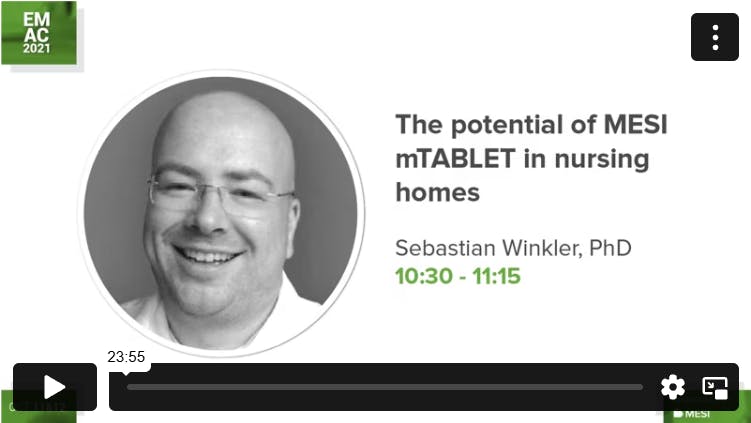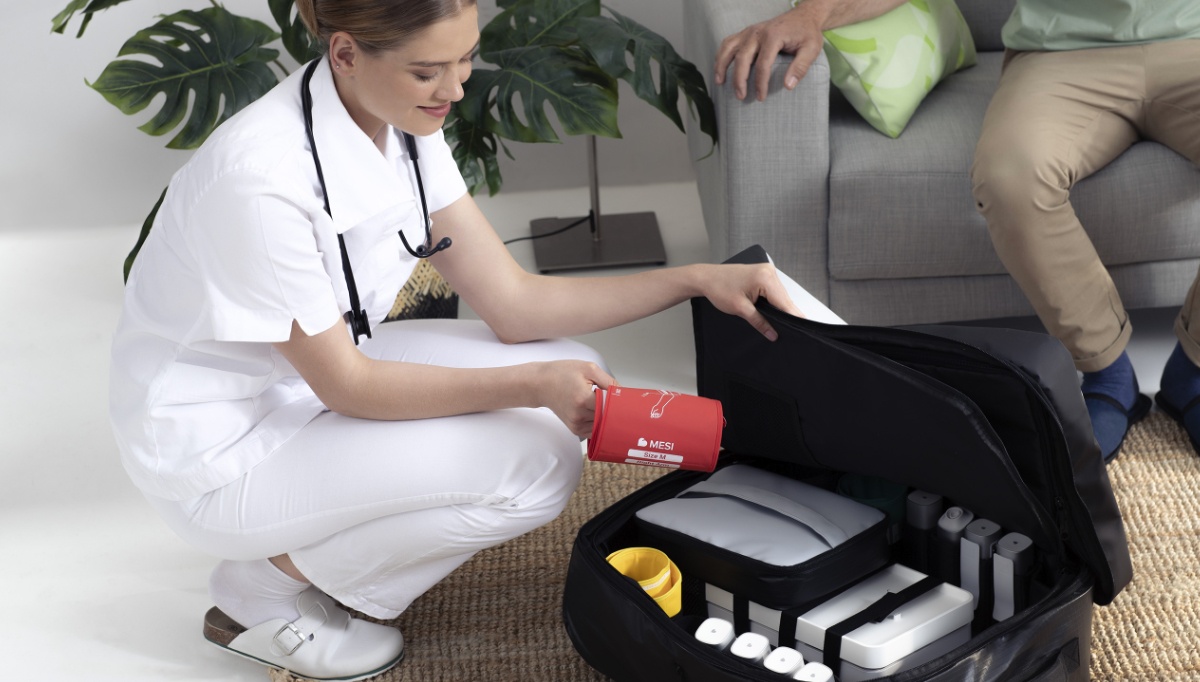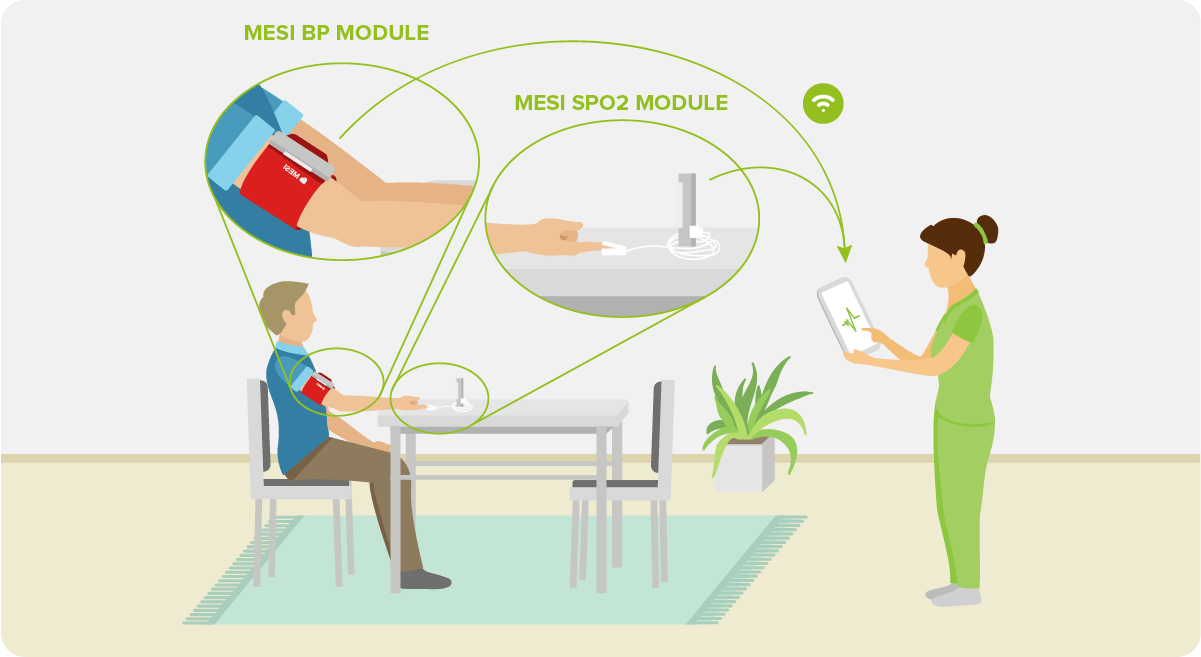The potential of the MESI mTABLET in nursing homes. Example of Germany

Germany has the most nursing home equipment in Europe, the highest number of nursing home facilities and a stable funding system [1], but faces the same problems as all other developed nations – a lack of nursing homes, a lack of medical staff and a limited nursing care budget [2].
Healthcare digitalisation at the regional [6] and national levels opens the space for new solutions to alleviate this burden. Digital solutions can optimise the information flow and make the diagnostic process faster. One of such innovations is the MESI mTABLET system.
The central advantage of the MESI mTABLET is in providing instant, wireless diagnostic result sharing. In case of health worsening, the resident’s diagnostic measurements can immediately be sent for review to a GP; this can make a GP visit or hospital transfer unnecessary. Furthermore, the all-round diagnostic system of the MESI mTABLET helps prevent fragmented diagnostics – performing individual diagnostic measurements at different locations. This lowers the costs, saves time to the nursing home staff, reduces emergency GP visits, and helps prevent potentially avoidable hospitalisations (PAHs).
Consequently, there are advantages for all stakeholders in German nursing home care. For nursing homes, preventing PAHs means fewer lost nights at their premises and thus more income. For GPs, carers and nurses, instant result sharing saves time and work while leading to a faster diagnosis. For health insurance companies, preventing PAHs means less expenditure and thus a relevant contribution to the healthcare system in general [2].
In this blog you will learn:
Nursing home statistics shows a growing opportunity
The central motivation of the stakeholders
Digital optimisation – case for medical staff
Digital optimisation – case for nursing homes
Digital optimisation – case for health insurance companies
Exploring the MESI mTABLET opportunity worldwide
Nursing home statistics shows a growing opportunity
The national statistics in Germany reveals the following opportunities and challenges:
Germany has the highest proportion of elderly population in Europe (21.1%) [1];
there are 13,500 nursing homes, with an average of 70 beds per unit, which makes 945,000 available beds altogether [1];
between 2020 and 2035, the number of people aged 67 or more will rise from 16 million to 20 million [3];
in 2020, there were 20,465 people aged 100 or older; this is higher than ever before, both in the absolute number and in proportion to the entire population [4];
in terms of the dependency ratio (number of aged 65 and older over the total population from 16 to 64), Germany is somewhat above the European average [1];
In 2018, the transaction volume in the nursing home and senior residence sector increased by 63% year-on-year to EUR 1.76 billion [1];
even if the share of elderly population remains steady, at least 230,000 new care places will have to be constructed by 2030 [2], not to mention the renovation and modernisation of the existing facilities;
in terms of healthcare personnel, Germany was third in the EU in 2018 with 1000 practicing nursing professionals per 100,000 inhabitants [5]. Nevertheless, there is a lack of medical professionals and it will continue to increase.
This data reveals a complex situation, but also ample opportunity for developing new digital solutions. Telemedicine, electronic health records (EHRs) and non-fragmented diagnostics address the pains of the stakeholders in nursing care: nursing homes, medical staff and insurance companies and support them in their central motivation.
The central motivation of the stakeholders
One of the biggest problems in nursing home care worldwide is the number of potentially avoidable hospitalisations (PAHs). PAHs of long-term nursing facility residents cost US taxpayers 11,000 USD per admission. It is estimated that 35% of all US hospitalisations of nursing facility residents are PAHs [7].
PAH prevention can:
prevent unnecessary medical work and transport,
save time to the nursing home staff in terms of unnecessary transport logistics,
save hundreds of thousands of nursing home residents from hospital-induced infections,
avoid stressing the residents and their families,
save billions. [7]
Let us have a look at how the MESI mTABLET can support each of the stakeholders not only in their central motivation, but also in terms of their daily workflow. You can find out more in this video by Dr Sebastian Winkler.

Digital optimisation – case for medical staff
German nursing homes employ carers and nurses, but not GPs. Those visit nursing homes from external practices and/or have residents come to them.

The MESI mTABLET enables a number of diagnostic measurements on one device. the biggest advantage is that the GP does not need to be present when they are performed. The measurements can be performed by nurses and instantly shared with the GP for telemedical assessment. This brings the following advantages for the medical and care staff:
it is easier to prevent PAH,
fewer emergency GP visits to the nursing home needed,
less logistics and transports to external locations (GP surgeries, hospitals) for diagnostic check-ups,
better quality of life for the nursing home residents.
The MESI mTABLET on the nursing home premises also enables regular health assessments of the residents, with the following staff motivations:
less regular transports to external locations (e.g. GP surgeries for an ECG),
earlier detection of health deteriorations and thus the chance to act sooner.
There is also financial motivation for GPs because, in Germany, telemedical coordination with the nursing home staff can be reimbursed. The same goes for ECGs during nursing home visits.
Digital optimisation – case for nursing homes
Financial motivation in emergency telemedical assessment
As already stated, one of the biggest advantages of telemedical assessment is in helping to prevent PAHs. If a nursing home resident undergoes unnecessary hospitalisation in Germany, that does not necessarily entail a financial loss for the nursing home in terms of lost nights. A 25% reduction of payment only applies after 4 nights.
However, a PAH can result in an infection of the resident in hospital. This means that they can be rehospitalised later. There is also a danger of infecting other nursing home residents. This should be avoided at all costs as it can result in multiple hospitalisations and thus a loss of income.
Financial motivation in regular health assessment
It is worth considering regular health assessments with the MESI mTABLET as pay-per-use or as included in a self-pay premium package.
Organisational motivation
Although not financial, the reduced workload for the nursing home staff in terms of less logistics to external locations is the biggest gain, contributing to the smoother work process of both the nursing home staff and the external GPs visiting. The MESI mTABLET contributes to a much more informed decision if a GP visit or hospitalisation is truly necessary.
Digital optimisation – case for health insurance companies
Motivated by cost reduction, health insurance companies are an important driver of healthcare digitalisation in Germany and elsewhere. Long-term reduction of PAHs can result in considerable savings in terms of nights spent in hospital. The MESI mTABLET could be an interesting project for the insurance companies – both in terms of response to acute health crises and regular health assessments at nursing homes.
Exploring the MESI mTABLET opportunity wordwide
In the EU alone, there are 48,500 nursing homes with 70 beds on average, which makes 3.4 million available beds in total [2]. Even the case of Germany, one of Europe’s most mature nursing home markets [1], shows that the market is underdeveloped. The total market potential of more than 200 EUR million calls for optimism and efforts in this regard [2].

To sum up, the MESI mTABLET can bring a valuable contribution to the digitalisation of nursing homes at the diagnostic level. Its advantages:
instant digital result sharing. The results of diagnostic check-ups can be instantly forwarded to the GP or hospital by email; this makes methods like faxes and telephone calls unnecessary, saving time and making the communication process smoother [8];
basic diagnostics on one device (ECG, blood pressure, SpO2, spirometry, ABI and TBI). It enables a much more informed decision on whether a hospitalisation is truly necessary; transfer to a hospital or GP office just to have a diagnostic check (e.g. an ECG) can be avoided;
the MESI mTABLET can importantly contribute to the national and regional goals of increasing digitalisation in healthcare.